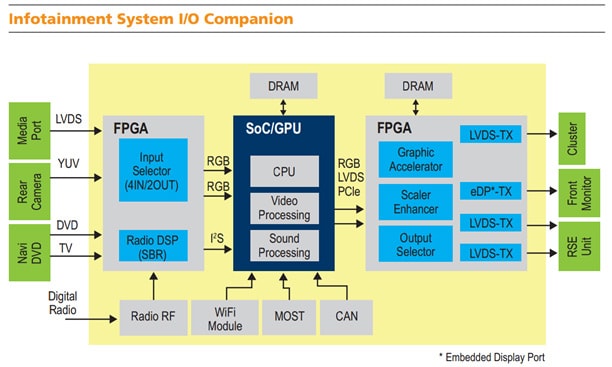Automotive Infotainment Takes a Front Seat
Infotainment in the traditional sense is media that conveys informative and entertaining content to consumers. Consumer electronics, such as tablets and smartphones, have changed the landscape of infotainment by offering a platform that delivers massive amounts of increasingly personalized data, whether it’s stock prices, weather information, or the latest meme trending on Reddit. The automotive industry is quickly moving to adopt this concept to modern vehicles. In-Vehicle Infotainment (IVI) means today’s cars offer: Connected, bring-your-own-device (BYOD), compatible, customizable, wireless, high-definition, state-of-the-art, voice-activated, touch-screen enabled, integrated, dash-mounted media systems—but can you find the button that turns it on?

Figure 1: This is an image of the infotainment of yesteryear.
In the simple years of the 20th century, automotive infotainment meant an AM/FM radio (Figure 1). Eventually, the center stack contained a tape deck—and a CD player, if you were fancy; or a 3-disc CD player, if you were super fancy. Lights, gauges, and indicators displayed oil pressure, water temperature, and well, you know the rest. The question of the hour was "What’s under the hood?" not "What’s on the dash?"
In the 21st century, the rules have changed. Most consumers today assess cars for practicality. While performance is still a factor, the question now is "What does my car have to offer that can enhance my productivity and overall driving experience?" We value our time; we value our experiences; and with a new era in consumer electronics, we value mobility and connectivity as well (Figure 2).

Figure 2: This is today's version of an infotainment system.
You can expect more cars are rolling off the line with some or all these automotive infotainment features. Here’s what infotainment means as it applies to das auto, in a nutshell (Table 1):
| Category | Features | Description |
| Human-Machine Interface (HMI) |
|
HMI is everything related to what the driver can see and touch and how the driver interacts with the car. |
| Connectivity |
|
Connectivity involves how a smart device connects to the car, or the car to the cloud, or the car to other cars. The US Department of Transportation’s (DOT) National Highway Traffic Safety Administration (NHTSA) announced a potential regulation that will mandate vehicle-to-vehicle (V2V) communications shortly. |
| Telematics |
|
Telematics is the "info" in infotainment: navigation and maps, weather alerts, vehicle status (oil temperature and pressure, battery voltage, water temperature, tire pressure and temperature). For some high-end cars like the 2014 Corvette Stingray, telematics also means displaying performance metrics, such as g's and lap times. |
| Radio/Audio/Video |
|
These comprise the entertainment media, such as videos, music, and podcasts, which do not include recording capabilities. |
| Advanced Driver Assistance Systems (ADAS) |
|
Driver distraction is not preventable, but it's manageable. ADAS includes an electronic control unit (ECU) dedicated solely for data logging (a black box) for convenient reviews in the event of a crash, front and rear cameras to eliminate blind spots, radar to approximate the distance relative to other vehicles, and a lane-departure warning system. |
Table 1: Infotainment features.
Texas Instruments, Analog Devices, NXP Semiconductors, and Altera are leading suppliers in offering innovative, Automotive Electronics Council qualified (AEC-Q) products for automotive infotainment systems.
For a comprehensive solution to automotive infotainment, NXP Semiconductors has come out with the i.MX 6 Series of processors. By combining the power-efficient processing capabilities of the Arm® Cortex™-A9 architecture with leading-edge 2D and 3D graphics as well as high-definition video, the i.MX 6 Series of single-, dual-, and quad-core processors provide a new level of multimedia performance. NXP has also partnered with QNX®, the real-time operating system software company recently acquired by Blackberry®, to deliver a complete hardware and software solution to the infotainment market.
Field-programmable gate arrays (FPGAs) are unique in that they allow engineers to future-proof their systems with post-production upgrades, which eliminates the need to manufacture a new printed circuit board (PCB) for every new board iteration. Altera's Cyclone V FPGAs address the technical challenges of increased integration and performance, lower power, and a faster time to market (TTM) while meeting cost requirements. For infotainment, the Cyclone V supports multiple camera inputs and display interfaces, includes an integrated radio digital signal processor (DSP), and has a hard-processor system centered on the dual-core Arm Cortex-A9 MPCore™ processor. With a rich set of peripheral blocks, Cyclone V FPGAs reduce a system’s power demand, cost, and board size.
An infotainment system naturally carries a host of peripheral technologies to support its life in-vehicle for thermal management, power management, Media Oriented Systems Transport (MOST) bus, electrostatic discharge protection, and vibration management (Figure 3). The Bourns® ChipGuard® MLC Series Automotive ESD protectors, for example, are designed specifically for use in automotive circuits requiring electrostatic discharge protection.

Figure 3: Infotainment system input/output (I/O) companion. (Source: Mouser Electronics)
Factors Affecting Automotive Infotainment Development
The rapid development cycle of the consumer electronics industry has consumers acclimated to expect newer, better, and faster, feature-loaded products in a matter of months. Contrast that with the development cycle of the automotive industry, where the fastest time a new vehicle goes from design to production is about two years—and that's pushing it.
To stay competitive, original equipment manufacturers (OEMs) have been working quickly to implement connected features into new vehicles. Some OEMs, such as Ford® and Mercedes Benz®, have come under fire for their implementation of infotainment. Mercedes Benz received criticism for integrating Facebook and Twitter into their infotainment system. Ford caught flack for software bugs and a confusing user interface. In a rush to be the first to market the 21st-century in-car experience, car makers risked coming across as off-point, haphazard, and counterproductive.
At the moment, IVI appears to be much like the Wild West of the auto industry. IVI’s unique partnerships between its OEMs and software providers as well as differences in its non-standard user interfaces (that is, its distinct icon and gesture styles for touch screen) stand in contrast to the de facto standard that iOS and Android have created in the smartphone and tablet industry.
There have been attempts to standardize infotainment, although these efforts have not been as successful as have been with Android or iOS. The GENIVI Alliance (pronounced 'gen-ee-vee'), founded in 2009, is a non-profit organization that develops standards, certifications, and open-source tools for OEMs, chipmakers, software developers, and other industry players to organize the development of IVI. GENIVI’s goals are:
- To deliver a reusable, open-source platform consisting of Linux-based core services, middleware, and open-application-layer interfaces
- To encourage developers to deliver compliant applications
- To sponsor technical, marketing, and compliance programs
It remains to be seen whether GENIVI will lose relevance in the market, especially with recent developments on the brewing infotainment battle between giants Apple® and Google. This year Apple launched CarPlay®, an operating system (OS) that allows compatibility between the car and other iOS devices. CarPlay has garnered interest from over fifteen OEMs including BMW®, Fiat Chrysler Automobiles (FCA), Ford, General Motors (GM), Honda, Toyota®, and Mazda, to name a few. Apple has also partnered with Pioneer and Alpine to offer after-market products based on CarPlay.
Microsoft® is working to get back in the game. Microsoft's previous in-car platform, SYNC®, showed initial success by being selected by Ford for its infotainment system; however, that story ended with Ford announcing it will not continue to implement SYNC in its vehicles, turning to QNX instead. Microsoft's new solution—Windows® in the car—seeks to integrate Windows-based mobile devices with a vehicle’s display, similar to Apple’s CarPlay. Microsoft has also partnered with Sony and Alpine to sell after-market products based on the Windows-in-the-car platform.
Google, not to be left out, announced that it has over forty partners in its Open Automotive Alliance. With an IVI system based on Android (Android Auto), Google has partnered with Audi®, Chevrolet®, Fiat®, Honda, Ford and electronics companies such as Delphi, LG, Panasonic, Renesas, and Freescale Semiconductor. These developments and partnerships bode well for Google and the future of automotive engineering, as major trends in the auto industry revolve around efficiency, connectivity, and safety—something Google is already working towards with its self-driving car.
Along with the standardization of hardware and software as a whole, consumers are also a major driver of the scope of infotainment. Customers who view an infotainment system negatively may apply that negativity towards the whole car and the brand itself. On the other side of the coin, customers who view infotainment positively may welcome the change and praise the OEM for its insight. Concerns such as driver distraction have been partially addressed with driver-assistance systems (DAS), but solutions to more complex issues such as privacy, security, and digital storage will continue to develop as infotainment matures.
With the wealth of features that automotive infotainment offers, OEMs and governments must take a serious look at features that are productive versus features that are superfluous. These infotainment options also require delineating between driver-centric or passenger-centric features. Telematics is driver-centric, and entertainment (Twitter/YouTube) is passenger-centric, but as a matter of safety, the features specific to each audience (that is, driver versus passenger) must not cross over.
Electronic systems are finding a place in every aspect of an automobile. This trend shows in such recent advances in automotive electronics as electronic stability control, traction control, airbag safety, power steering, satellite radio, emissions controls, active suspension, anti-lock brakes, noise cancellation, powertrains (hybrid/all-electric), and the list goes on and on. Automotive infotainment is growing in popularity and taking root to become another major driver of competition shortly. As it’s such a new field, infotainment has yet to take on an exact definition, which is part of the reason it’s so exciting. We have yet to witness the latest technologies and applications that will evolve as automobiles become more connected and highly integrated smart devices in and of themselves. Truly, the only limit to the development of infotainment is our imagination.
We're right on the cusp of the next generation of automobiles. Not only will future cars be safer, connected, personalized, and cleaner for the environment, they'll also become "smartphones on wheels."